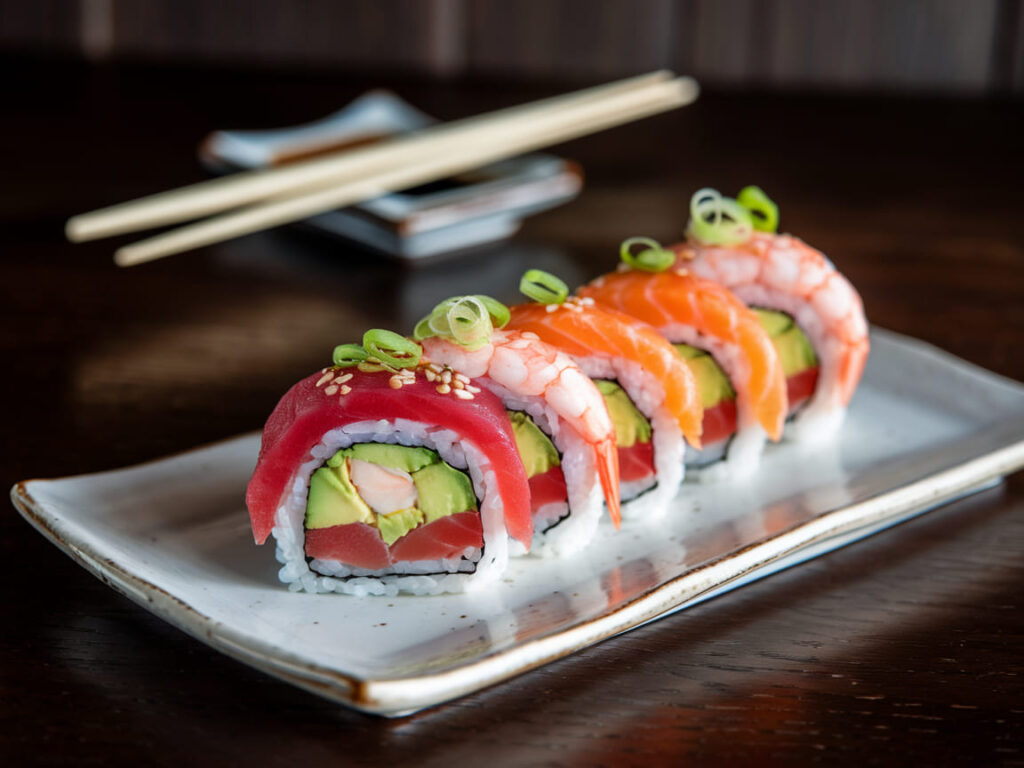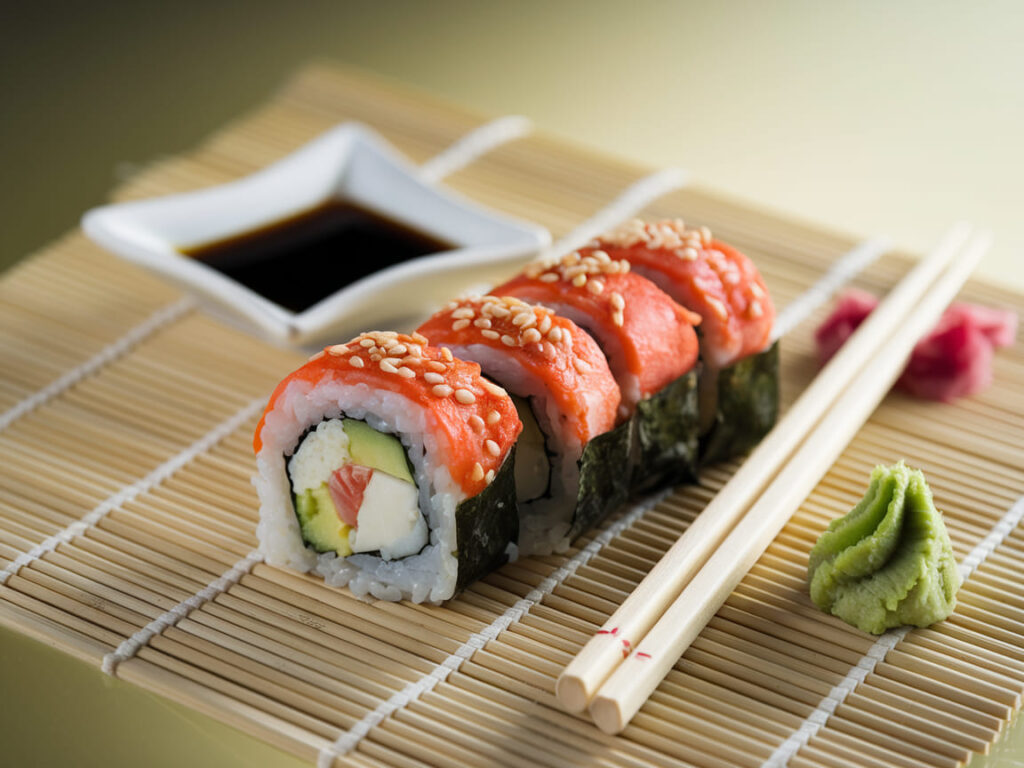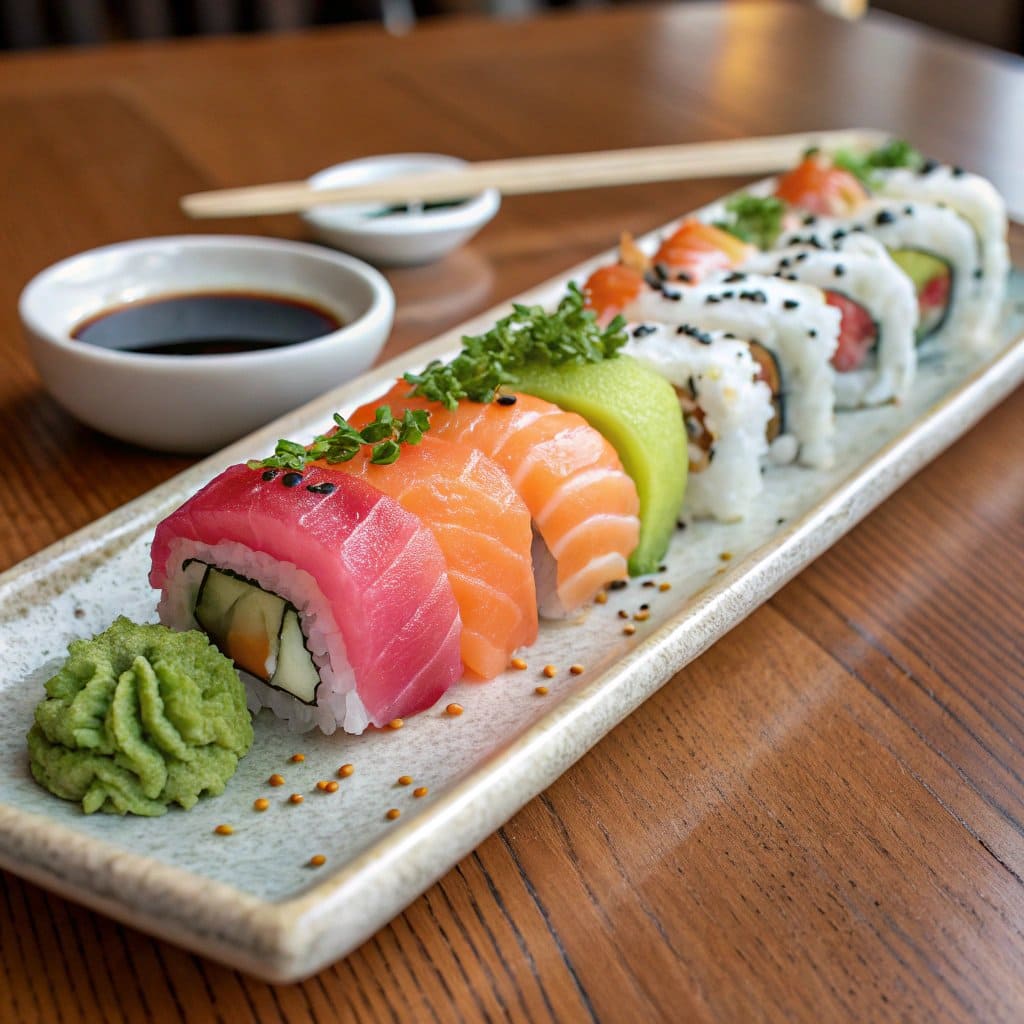The Difference Between Rainbow Roll and California Roll Sushi Explained! Sushi has taken the world by storm, offering a blend of taste, artistry, and culture. Among the vast selection of sushi rolls, two names stand out for their popularity: Rainbow Roll and California Roll. These rolls aren’t just delicious; they’re a feast for the eyes and a celebration of creativity.
What makes these rolls so irresistible? Is it their bold flavors, their stunning appearance, or the way they bridge traditional and modern tastes? In this article, we’ll dive deep into what makes the Rainbow Roll and California Roll unique and why they’ve become favorites for sushi lovers everywhere.
Table of Contents
The Basics of Sushi Rolls
Sushi rolls, or makizushi, are a type of sushi where ingredients are rolled in rice and seaweed (nori). They come in various forms, often customized with creative fillings and toppings. However, the Rainbow Roll and California Roll each bring something special to the table.
- Rainbow Roll: A vibrant roll featuring a variety of colorful fish on top.
- California Roll: A simpler, inside-out roll with creamy avocado, crab, and cucumber.
Now, let’s explore their ingredients, flavors, and history to uncover their irresistible charm.
What Is a Rainbow Roll?

The Rainbow Roll is a visual masterpiece and a treat for seafood lovers. This sushi roll gets its name from the colorful array of toppings that resemble a rainbow. Each slice is a burst of vibrant hues and fresh flavors, making it a favorite choice at sushi restaurants.
Ingredients in a Rainbow Roll
The Rainbow Roll typically starts with a base similar to a California Roll, including:
- Sushi rice: Soft, vinegared rice as the foundation.
- Seaweed (nori): A thin sheet to hold the roll together.
- Crab meat or imitation crab: Adds a sweet, delicate flavor.
- Avocado: Creamy and rich, balancing the texture.
- Cucumber: Fresh and crisp for a satisfying crunch.
What sets the Rainbow Roll apart is the assortment of fish layered on top:
- Tuna: Bright red slices that bring boldness.
- Salmon: Tender and rich in flavor.
- Yellowtail or snapper: Adds a light and buttery touch.
- Shrimp: Cooked and sweet for extra variety.
Flavor Profile of a Rainbow Roll
The Rainbow Roll offers a mix of flavors that blend beautifully. The sweetness of the crab, the creaminess of the avocado, and the freshness of the fish on top create a balanced and satisfying bite. Each piece feels like a mini celebration of taste and texture.
What Is a California Roll?

The California Roll is one of the most iconic and beginner-friendly sushi rolls. Known for its simplicity and lack of raw fish, it has won over even those hesitant to try sushi. This roll paved the way for sushi’s popularity outside Japan, making it a beloved choice worldwide.
Ingredients in a California Roll
The California Roll features simple yet delicious ingredients that come together seamlessly:
- Sushi rice: Lightly seasoned with rice vinegar for a subtle tang.
- Nori (seaweed): Used to hold the roll together, often inside the roll for a clean outer look.
- Imitation crab or real crab: Provides a mildly sweet and savory flavor.
- Avocado: Creamy and smooth, balancing the other textures.
- Cucumber: Adds a refreshing crunch and lightness.
Some variations may include mayonnaise or sesame seeds for added flavor and texture.
Why the California Roll Is Unique
One of the key differences with the California Roll is that it’s an inside-out roll, meaning the rice is on the outside while the seaweed wraps the filling inside. This unique presentation not only makes it visually appealing but also creates a softer texture when eaten.
Flavor Profile of a California Roll
The California Roll is mild, creamy, and refreshing. The buttery avocado complements the sweet crab meat, while the cucumber brings a crunchy, fresh element. It’s no wonder this roll is often the go-to for first-time sushi eaters!
How Are Rainbow Roll and California Roll Different?
The Rainbow Roll and California Roll may share some similarities, but their differences are what make them stand out in the sushi world. From their presentation to the ingredients, these two rolls cater to unique tastes and preferences.
Presentation
- Rainbow Roll: Known for its vibrant and colorful appearance, the Rainbow Roll features slices of various fish layered on top of the roll. This eye-catching presentation makes it a favorite for special occasions or when you want a sushi roll that stands out.
- California Roll: The California Roll has a simpler look, with the rice on the outside and often sprinkled with sesame seeds. Its clean and minimalist presentation is ideal for those who prefer a straightforward sushi experience.
Ingredients
- Rainbow Roll: Includes a variety of fresh fish such as tuna, salmon, yellowtail, and shrimp on top. These toppings add complexity to the flavor and make it appealing for seafood enthusiasts.
- California Roll: Typically contains imitation crab, avocado, and cucumber as the primary ingredients. There’s no raw fish, making it a safer choice for beginners or those avoiding raw seafood.
Flavor Profiles
- Rainbow Roll: Offers a mix of textures and flavors, from the buttery avocado to the rich fish. It’s bold, adventurous, and perfect for sushi lovers looking for a dynamic taste experience.
- California Roll: Mild and creamy, with a balance of sweetness and freshness. Its simple flavors make it a comforting option that appeals to a wide range of palates.
Popularity
Both rolls are incredibly popular, but their audiences differ slightly:
- The Rainbow Roll attracts those who appreciate artistic sushi with complex flavors.
- The California Roll is often the gateway for sushi beginners, thanks to its simplicity and lack of raw fish.
The Secret to Their Popularity
The enduring popularity of the Rainbow Roll and California Roll isn’t just about their taste—it’s also about what they represent. These sushi rolls combine creativity, accessibility, and a hint of tradition, making them stand out on menus worldwide.
Accessibility and Appeal
- California Roll: This roll made sushi approachable for people unfamiliar with raw fish. By using imitation crab, avocado, and cucumber, it offers mild flavors that are comforting yet delicious. Its inside-out style, with rice on the outside, also helped make sushi visually less intimidating to beginners.
- Rainbow Roll: The Rainbow Roll, while a bit more adventurous, is still a crowd-pleaser. By building on the familiar base of a California Roll, it adds an artistic flair with slices of fresh fish on top. This blend of familiarity and creativity appeals to sushi lovers looking for something a little extra.
Stunning Presentation
Presentation plays a huge role in the success of these rolls:
- Rainbow Roll: Its bright, colorful appearance is irresistible and perfect for Instagram-worthy photos. The vibrant fish slices on top make it look fresh, luxurious, and exciting.
- California Roll: Its clean, polished look with sesame seeds or a sprinkle of roe on the outside gives it a simple elegance that appeals to a wide audience.
Versatility
Both rolls are highly versatile and can be adjusted to meet dietary preferences:
- Vegetarian versions can replace crab or fish with ingredients like tofu or extra avocado.
- They’re customizable, with optional sauces like spicy mayo, eel sauce, or soy sauce to enhance flavor.
The Sushi Revolution
The California Roll played a pivotal role in popularizing sushi in Western countries. By removing raw fish from the equation, it made sushi less intimidating and helped establish a sushi-loving culture. Similarly, the Rainbow Roll built on this foundation by introducing the beauty and artistry of sushi to a broader audience.
Are They Healthy Choices?
When it comes to sushi, many people wonder whether the Rainbow Roll and California Roll are healthy options. The good news is that both can be nutritious, depending on the ingredients and portion sizes. Let’s break it down.
Nutritional Benefits of a Rainbow Roll
The Rainbow Roll is packed with fresh fish, which brings a variety of health benefits:
- High in protein: The fish toppings provide lean protein, essential for muscle growth and repair.
- Rich in omega-3 fatty acids: Fish like salmon and tuna are great sources of omega-3s, which promote heart and brain health.
- Vitamins and minerals: Fish and avocado contain nutrients like vitamin D, B vitamins, and potassium.
However, it’s worth noting that the Rainbow Roll can be higher in calories due to the variety of fish and toppings. Adding sauces like spicy mayo can also increase fat and calorie content, so moderation is key.
Nutritional Benefits of a California Roll
The California Roll is a lighter option and a good source of several nutrients:
- Low in fat: Its core ingredients—imitation crab, avocado, and cucumber—are relatively low in fat (except for the healthy fats in avocado).
- Fiber and hydration: The cucumber adds fiber and water content, which aids digestion.
- Lower calorie option: Typically, California Rolls have fewer calories than more elaborate sushi rolls like the Rainbow Roll.
Potential Concerns
While both rolls offer health benefits, there are a few considerations:
- Rice: Sushi rice is seasoned with sugar and vinegar, which can add calories. Eating large portions may increase carbohydrate intake.
- Sodium: Dipping sushi in soy sauce or including imitation crab, which is often processed, can raise sodium levels.
- Portion control: It’s easy to eat several rolls in one sitting, which can lead to overeating.
Tips for Making Healthier Choices
- Opt for brown rice sushi for added fiber.
- Use less soy sauce or choose a low-sodium version.
- Skip high-calorie sauces and stick to fresh ingredients.
- Pair sushi with a side salad or miso soup for a balanced meal.
Both the Rainbow Roll and California Roll can be part of a healthy diet when eaten mindfully. Want to learn how to make these rolls at home?
How to Make Them at Home
Making sushi at home may sound intimidating, but with a little practice, you can recreate the deliciousness of Rainbow Rolls and California Rolls in your own kitchen. Plus, homemade sushi allows you to customize ingredients for your taste and dietary needs.
Tools You’ll Need
Before you begin, gather the essential tools for sushi-making:
- Bamboo sushi mat (makisu): To roll your sushi evenly.
- Sharp knife: For clean cuts through the roll.
- Plastic wrap: Prevents the rice from sticking to the bamboo mat.
- Rice paddle (shamoji): For spreading rice evenly.
Ingredients for Both Rolls
Here’s what you’ll need for the base of both rolls:
- Sushi rice: Short-grain rice, cooked and seasoned with rice vinegar, sugar, and salt.
- Nori sheets: Seaweed for wrapping the roll.
- Avocado: Sliced thinly for the filling.
- Cucumber: Cut into thin strips.
- Imitation crab or real crab meat: Use your preference.
For the Rainbow Roll, you’ll also need:
- Assorted fish: Thin slices of tuna, salmon, yellowtail, and shrimp.
Step-by-Step Instructions for a California Roll
- Prepare the sushi rice: Cook short-grain rice and season it with rice vinegar, sugar, and salt. Let it cool.
- Lay out the nori: Place a sheet of nori on the bamboo mat.
- Add rice: Spread a thin layer of rice over the nori, leaving about an inch uncovered at the top.
- Flip the nori: Gently flip it over so the rice is facing down.
- Add fillings: Place cucumber, avocado, and crab in a line across the nori.
- Roll it up: Use the bamboo mat to roll the nori tightly into a cylinder.
- Slice and serve: Cut the roll into even pieces using a sharp knife.
Step-by-Step Instructions for a Rainbow Roll
- Follow the California Roll steps: Make a California Roll as the base.
- Add fish toppings: Lay slices of tuna, salmon, shrimp, and other fish on top of the roll.
- Wrap with plastic: Place plastic wrap over the roll and gently press the fish onto the rice.
- Slice the roll: Cut the roll into pieces through the plastic wrap, then remove the plastic.
- Serve with garnishes: Add a sprinkle of sesame seeds or thinly sliced green onions for an extra touch.
Pro Tips for Success
- Keep your hands wet while handling the rice to prevent it from sticking.
- Use the freshest fish possible, especially for the Rainbow Roll.
- Experiment with sauces like spicy mayo or eel sauce for added flavor.
You Might Also Like
If you enjoyed learning about the irresistible charm of the Rainbow Roll and California Roll, you’ll love exploring more delicious recipes and food ideas. Check out our guide on the Rainbow Roll to dive deeper into this colorful sushi masterpiece. For a sweet twist, try the Peach Crumble Recipe or indulge in the Easy Triple Berry Crumble with Oats for a dessert that’s as simple as it is satisfying!
Frequently Asked Questions
What’s the Difference Between Sushi and Sashimi?
Sushi includes vinegared rice combined with ingredients like fish or vegetables, while sashimi is just thinly sliced raw fish or seafood served without rice.
Can I Make Sushi Without a Bamboo Mat?
Yes! Use a clean kitchen towel or parchment paper as an alternative for rolling sushi.
Is It Safe to Eat Raw Fish in Sushi?
Yes, if you use sushi-grade fish from a trusted source. It’s specially prepared to be safe for raw consumption.
Are There Vegetarian Versions of These Rolls?
Definitely! Replace fish in the Rainbow Roll with sliced vegetables like bell peppers or carrots. For the California Roll, swap crab for avocado or tofu.
How Many Calories Are in Each Roll?
- California Roll: About 250–300 calories.
- Rainbow Roll: Around 350–400 calories, due to the fish toppings.
What’s the Best Way to Store Leftover Sushi?
Wrap tightly in plastic wrap and store in the fridge. Eat within 24 hours for freshness.
Conclusion
The Rainbow Roll and California Roll showcase the artistry and variety of sushi. From the colorful elegance of the Rainbow Roll to the simple charm of the California Roll, each has its unique appeal. Why not try making them at home and enjoy these delicious rolls anytime?

